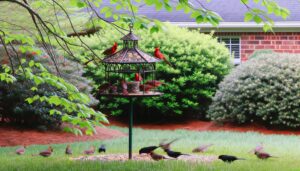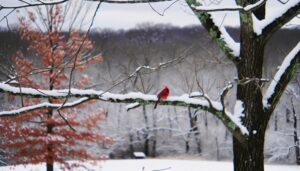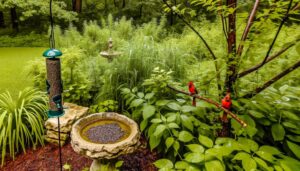Understanding Cardinal Nesting: Do Cardinals Return to the Same Nest?
Cardinals rarely return to the same nest each season. They prefer building new nests in dense shrubs or low tree branches to improve concealment and protection from predators.
Seasonal breeding activities influence nest-building, with peak periods in early spring and summer. Factors like environmental stability and predation risks also impact nest site selection.
Severe weather can damage old nests, making them unsuitable for reuse. By building fresh nests, cardinals ensure best conditions for egg incubation and chick rearing.
Explore further to understand how seasonal patterns and habitat preferences shape their nesting behavior.
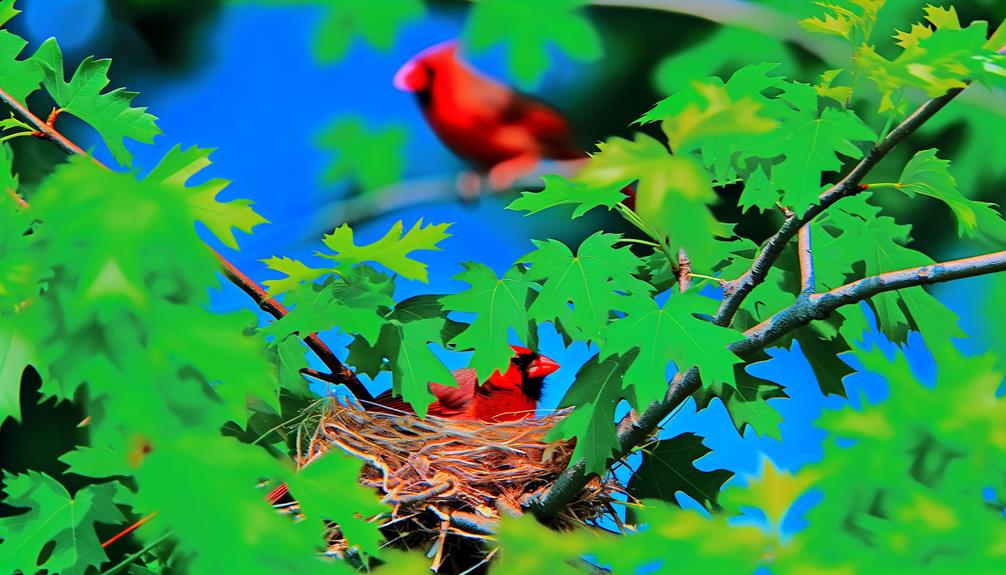
Key Takeaways
- Cardinals typically build new nests each breeding season rather than reusing old ones.
- Severe weather or nest damage often makes old nests unsuitable for reuse.
- Environmental changes like food availability and predation risks influence nest site selection.
- Cardinals prioritize choosing well-concealed and stable nest locations to protect their young.
- Nest abandonment occurs if a nest becomes too exposed, leading to new nest construction.
Cardinal Nesting Habits
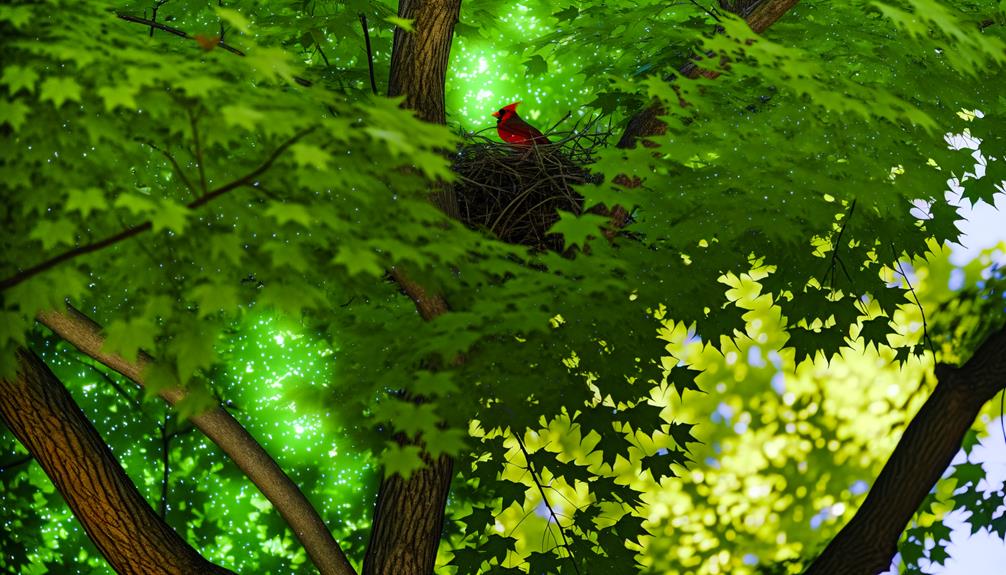
Observing cardinal nesting habits, you'll find that these vibrant birds prefer building their nests in dense shrubs or low tree branches. They typically select locations that offer ample cover to protect their young from predators.
Cardinals use a mix of twigs, leaves, and grasses to construct their nests, ensuring the structure is both sturdy and discreet. You'll notice that female cardinals take the lead in nest-building, while males assist by gathering materials. Their nests are usually cup-shaped, providing a snug environment for their eggs.
Seasonal Nesting Patterns
Throughout the year, cardinals exhibit distinct seasonal nesting patterns, with breeding activities typically peaking in the spring and early summer months. You'll notice that during these periods, cardinals are most active in nest building, egg-laying, and chick-rearing. The table below highlights key periods of cardinal nesting activities:
| Activity | Peak Months |
|---|---|
| Nest Building | March – April |
| Egg-Laying | April – June |
| Chick-Rearing | May – July |
Cardinals often raise multiple broods within a season, demonstrating a high degree of parental investment. By understanding these patterns, you can better appreciate the dynamic life cycle of cardinals and their adaptability to seasonal changes. Observing these behaviors provides insight into their reproductive strategies and survival mechanisms.
Nesting Site Preferences

Cardinals typically choose nesting sites that offer dense foliage and ample cover, providing protection from predators and harsh weather conditions.
You'll find these birds preferring environments that meet specific criteria:
- Vegetation Density: Cardinals often nest in shrubs, thickets, and low trees, where dense foliage conceals their nests from potential threats.
- Elevation: They usually build nests at heights ranging from 3 to 10 feet above the ground, balancing accessibility and safety.
- Proximity to Food Sources: Nesting sites near abundant food sources, such as seeds, fruits, and insects, are highly favored.
Factors Influencing Nest Location
When examining factors that influence a cardinal's choice of nest location, you should consider environmental stability and predation risk.
Cardinals seek areas with consistent resources and favorable weather conditions to guarantee the survival of their offspring.
Additionally, they avoid sites with high predation risk to protect their nests from potential threats.
Environmental Stability
Environmental stability plays an important role in a cardinal's decision to return to the same nest, as consistent conditions guarantee safety and resource availability for raising their young. When environmental factors remain stable, cardinals can rely on predictable resources and a secure habitat.
You might notice that cardinals prefer areas where:
- Food Sources: Abundant and reliable food sources, such as seeds and berries, are readily available.
- Temperature: Temperatures remain within a range suitable for egg incubation and chick development.
- Vegetation: Dense vegetation provides shelter and materials for nest building.
These factors create an ideal environment, reducing the need for relocation. You'll find that cardinals are more likely to return to nests in stable environments, ensuring better survival rates for their offspring.
Predation Risk
Nest placement is essential for minimizing predation risk, as a well-concealed nest can greatly enhance the survival rates of cardinal offspring.
You'll find that cardinals often choose dense shrubs or thickets to build their nests, which provide natural camouflage. These locations are selected to deter predators like snakes, squirrels, and larger birds.
Additionally, cardinals prefer sites that offer multiple escape routes, allowing them to quickly flee if threatened. You might notice that they avoid placing nests too close to the ground, reducing the risk from terrestrial predators.
Cardinal Mating Behavior
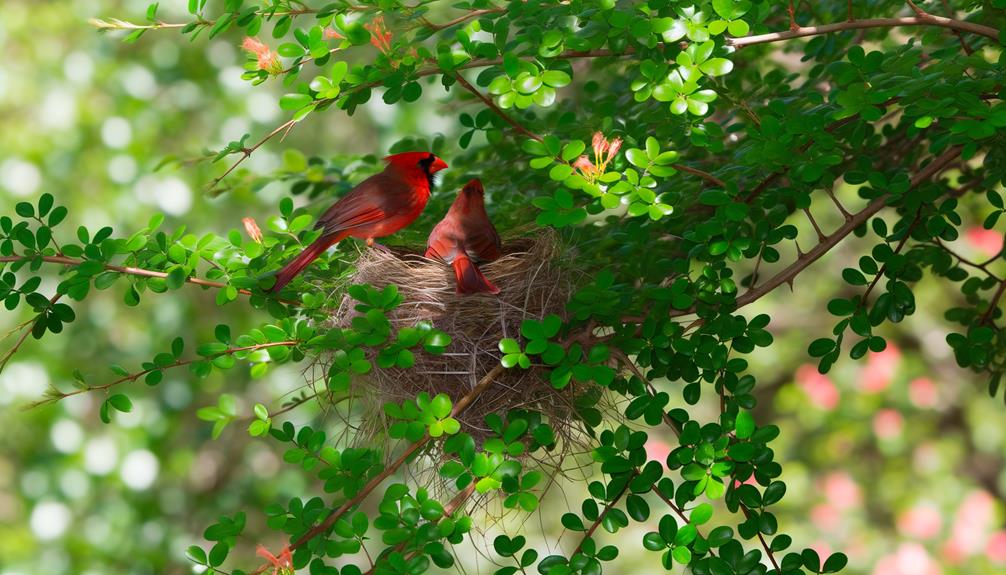
During the breeding season, cardinals exhibit monogamous mating behavior, often forming long-term pair bonds that can last for several years. You'll find that these bonds are reinforced through various behaviors and rituals that are both fascinating and intricate.
- Courtship Feeding: The male cardinal feeds the female to strengthen their bond and demonstrate his ability to provide.
- Singing Duets: Both male and female cardinals engage in vocalizations, harmonizing to establish territory and communicate.
- Mutual Preening: This behavior involves the birds grooming each other, fostering affection and reinforcing their pair bond.
These actions illustrate the cardinals' commitment to their partner, ensuring a stable environment for raising their young. This stability is key to their reproductive success.
Nest Construction Process
When examining the nest construction process of cardinals, you'll find they carefully select materials based on availability and durability.
They exhibit specific nesting location preferences, often choosing dense shrubs or low tree branches to guarantee safety and concealment.
Additionally, cardinals engage in seasonal nest building, constructing new nests multiple times throughout the breeding season.
Material Selection Criteria
Cardinals meticulously choose pliable twigs, grasses, and leaves to guarantee their nests provide adequate support and insulation for their eggs. This careful selection process involves evaluating each material for its structural integrity and thermal properties.
- Pliable Twigs:
These are essential for creating a sturdy framework that can withstand various weather conditions.
- Grasses:
Soft grasses are used to line the nest, providing a comfortable and insulating layer to protect the eggs.
- Leaves:
Leaves add an additional layer of insulation and camouflage, helping to conceal the nest from potential predators.
Nesting Location Preferences
After selecting the right materials, these birds exhibit a strong preference for nesting locations that provide safety, proximity to food sources, and suitable environmental conditions.
You'll often find cardinals choosing dense shrubs or low tree branches, usually between 3 to 10 feet off the ground. This height provides protection from predators while maintaining access to nearby food. They favor areas with dense foliage, which offers concealment and shelter from the elements.
Cardinals are adaptive and may select sites near human habitation if the environment meets their criteria. They avoid exposed, high-traffic areas to minimize disturbances. By prioritizing these factors, cardinals make certain their nests are secure and conducive to raising their young successfully.
Seasonal Nest Building
During the breeding season, these vibrant birds engage in a careful process of constructing their nests, which involves gathering various natural materials like twigs, bark strips, and grasses. You'll observe that cardinals are highly selective about their nesting materials.
The female primarily builds the nest while the male supports by gathering materials.
Here's a breakdown of the nest construction process:
- Material Collection: Twigs form the nest's structure, bark strips provide insulation, and grasses create a soft lining.
- Nest Shaping: The female shapes the nest into a cup-like form using her body and feet.
- Location Selection: They prefer dense shrubs or low tree branches to secure concealment and protection from predators.
This process establishes a secure and comfortable environment for their offspring.
Nest Reuse Instances

In various observed cases, the Northern Cardinal exhibits a tendency to reuse nests, albeit infrequently and typically under certain favorable conditions. You'll find that such conditions include the nest's structural integrity and the absence of parasites. If the nest remains sturdy and free from infestation, a cardinal may return instead of building anew.
This behavior usually occurs during the same breeding season, as the effort required to construct a new nest is thereby minimized. Additionally, reusing a nest can expedite the reproductive process. However, don't expect this to be the norm. Cardinals, valuing ideal conditions for their offspring, often opt for fresh nest sites to ensure safety and suitability. This pattern underscores their adaptive strategies in nest utilization.
Territorial Behavior
Understanding their nesting habits also involves examining the Northern Cardinal's territorial behavior, which plays a significant role in their reproductive success and nest site selection. You'll find that cardinals are highly territorial, especially during the breeding season. Males establish and defend territories to secure access to resources and to attract females.
- Territory Size: A male cardinal's territory typically spans about 1 to 1.5 acres, securing enough food and nesting sites.
- Defense Tactics: Males use songs and physical displays to fend off intruders, maintaining the integrity of their territory.
- Mate Attraction: A well-defended territory with ample resources increases a male's appeal to potential mates.
This territorial behavior directly influences where and how often they nest within a given area.
Predation and Nest Safety

Predation poses a vital threat to Northern Cardinals' nests, requiring strategic nest site selection and vigilant behavior to safeguard the safety of their offspring.
You'll notice that cardinals often choose dense, thorny shrubs or trees to build their nests. This habitat choice helps to deter predators such as snakes, squirrels, and larger birds.
Cardinals also exhibit vigilant behavior, frequently checking their surroundings and issuing alarm calls when potential threats are nearby. They may even abandon a nest if it becomes too exposed.
These adaptive strategies are essential for reducing predation risks and ensuring the survival of their young. By understanding these behaviors, you can appreciate the intricate balance cardinals maintain to thrive in their natural habitats.
Environmental Influences
Environmental factors greatly impact Northern Cardinals' nesting behaviors and success rates. You'll find that these birds are influenced by various external conditions, which can determine whether they reuse a nest or build a new one.
Here are three key environmental influences:
- Weather Conditions: Severe weather, such as storms or extreme temperatures, can damage nests, making them unsuitable for reuse.
- Food Availability: The abundance of food sources in an area can encourage cardinals to return, while scarcity might drive them to seek new locations.
- Habitat Changes: Deforestation, urban development, or changes in vegetation can disrupt their preferred nesting sites, prompting relocation.
Observing Cardinals at Home
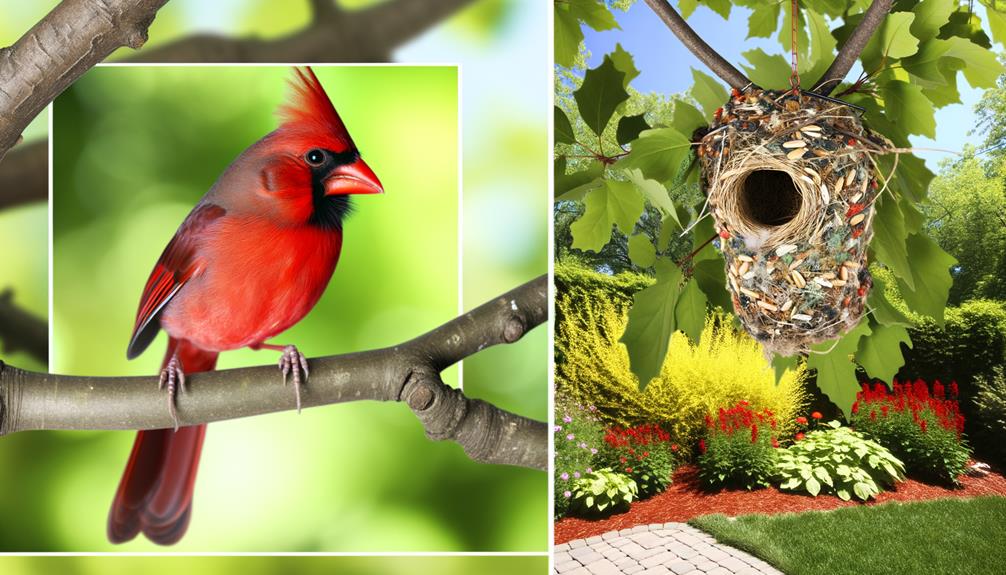
To effectively observe cardinals at home, you'll need to identify their nests, which are typically well-hidden in dense shrubs or trees.
Pay attention to their seasonal nesting patterns, as cardinals usually build new nests for each breeding season.
Identifying Cardinal Nests
When identifying cardinal nests, you'll often find them skillfully concealed within dense shrubs, small trees, or thickets, typically at a height of 3 to 10 feet above the ground.
To accurately identify a cardinal nest, look for the following characteristics:
- Nest Structure: Cardinals create a cup-shaped nest using twigs, bark strips, and grasses, lined with softer materials like pine needles or animal hair.
- Location: Nests are often built in well-hidden spots, providing protection from predators and harsh weather.
- Eggs: Cardinal eggs are usually white or light gray with brown or purple speckles and are about 1 inch in length.
Seasonal Nesting Patterns
You can observe cardinals' seasonal nesting patterns by noting their preference for building nests multiple times a year, specifically during spring and summer. These periods align with ideal conditions for rearing their young.
You'll find that cardinals typically construct their nests in dense shrubs or low tree branches, providing sufficient cover and accessibility. Each breeding pair may produce two to three broods per season, necessitating multiple nesting sites.
By tracking these patterns, you can better understand their reproductive strategies and territorial behavior. Pay attention to changes in nesting locations, as cardinals rarely reuse old nests, preferring fresh sites for each brood.
This practice minimizes the risk of predation and parasitism, ensuring higher survival rates for their offspring.
Encouraging Cardinal Nesting
Creating an inviting environment for cardinals involves providing ample food sources, safe nesting areas, and consistent water supplies.
To promote cardinal nesting, you should focus on three key aspects:
- Food: Offer a variety of seeds such as sunflower and safflower in feeders. Cardinals are drawn to these nutrient-rich options.
- Nesting Sites: Plant dense shrubs and trees like dogwoods and evergreens. These provide the cover and protection cardinals need to feel secure while nesting.
- Water: Guarantee a reliable water source by placing birdbaths or small ponds in your yard. Regularly clean and refill them to maintain freshness.
Conclusion
You might wonder if cardinals return to the same nest each year. While they're not known for reusing nests, they often nest in the same vicinity. Cardinals prefer dense shrubs and trees, ensuring ample cover from predators. Their nesting habits are influenced by factors like food availability and environmental conditions.
Observing these vibrant birds at home can be rewarding—plant native shrubs and provide a steady food supply to encourage their nesting. Don't worry, they adapt well to changing environments.



